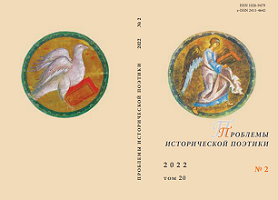«Дневник мыслей» и цикл «Легенды в веках» А. М. Ремизова: от эго-документа к жанру художественной прозы
“Diary of Thoughts” and the “Legends Through the Ages” Cycle by A. M. Remizov: from the Ego-Document to the Genre of Fiction
Author(s): Alla GrachevaSubject(s): Russian Literature, Sociology of Culture, Sociology of the arts, business, education, Theory of Literature, Sociology of Literature
Published by: Петрозаводский государственный университет
Keywords: Alexei Remizov; style; avant-garde; 20th-century prose; Old Russian literature; “Diary of Thoughts”; “Legends Through the Ages”; genre; legend;
Summary/Abstract: The article analyzes the creative role of the “Diary of Thoughts” — a unique documentary fiction text, which Remizov kept in 1943–1957, in the literary history of the “Legends in the Ages” prose cycle (1947–1955). The cycle includes Remizov’s reworkings of Old Russian original and translated texts: “A Tale of Two Beasts. Ikhnelat” (1947–1949), “Savva Grudtsyn” (1948–1949), “Bruntsvig” (1949), “Melyuzina” (1949–1950), “Bova Korolevich” (1950–1951), “Tristan and Isolda” (sic! — A. G.) (1951–1953), “About Peter and Fevronia” (1951), “Gregory and Xenia” (1954–1955). The dynamics of the writer’s creative development of ancient texts, the creation of a cycle of legends based on them and the role of the “Diary of Thoughts” in this process are considered using the most illustrative examples (“The Tale of Two Beasts. Ikhnelat,” “Savva Grudtsyn,” “Melyuzina,” “About Peter and Fevronia,” “Tristan and Isolda”). A number of conclusions were made: 1) Remizov’s “Diary of Thoughts” is an important source, which, along with plans, sketches, draft and white editions, allows to recreate all stages of the literary history of the “Legends Through the Ages” cycle; 2) “Diary of Thoughts” allows to look inside Remizov’s “creative laboratory”: reveal all the details of the origin and subsequent incarnation the author’s idea with chronological precision; to “see” the initial images that arose in the writer’s consciousness during his “borderline state” between sleep and reality, and then to follow Remizov’s search for ways to further “materialize” them in the verbal fabric of the work; 3) The “Diary of Thoughts”, which Remizov began to keep in 1943, shortly after the death of his beloved wife, provides the opportunity to trace the evolution of his state of mind, which was reflected in his works. From hopeless grief and awareness of the inescapable loneliness, the writer gradually arrives at the idea of the possibility of metaphysical overcoming of death. As a result, the myth of the immortality of love became the meta-plot of the “Legends in the Ages” cycle.
Journal: Проблемы исторической поэтики
- Issue Year: 20/2022
- Issue No: 2
- Page Range: 368-385
- Page Count: 18
- Language: Russian

